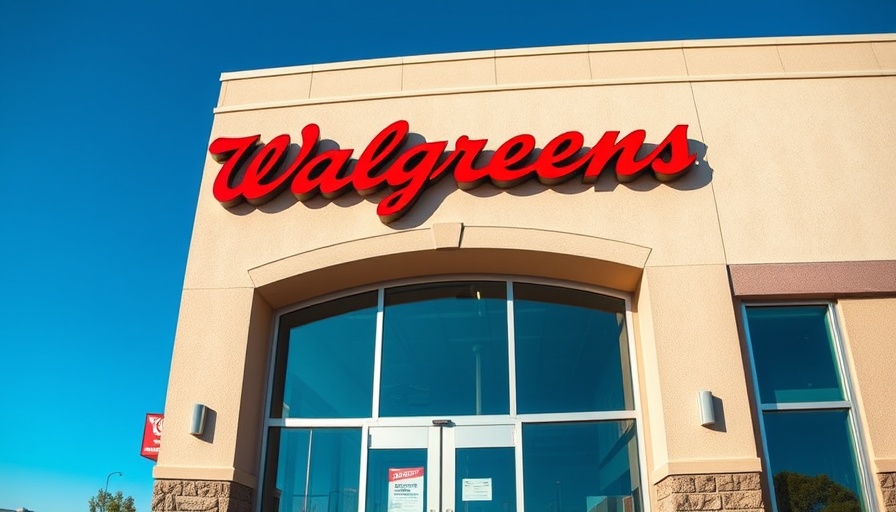
Walgreens Is On The Brink: A New Era Approaches
As Walgreens prepares to transition from a public company to a private entity, it recently reported its second-quarter results that illuminate both struggles and resilience. The retail pharmacy giant posted $38.6 billion in revenue, reflecting a 4% increase year-over-year. Yet, the company still faced a significant loss of $2.9 billion—though this represents a notable improvement from the staggering $5.9 billion loss reported in the same period last year. This shift signals a pivotal moment for Walgreens amidst the impending $10 billion take-private buyout with Sycamore Partners.
What Does The Transition Mean for Walgreens?
The impending buyout could alter Walgreens' future direction significantly. As many market analysts suggest, Sycamore Partners may exercise a strategy of breaking up the drugstore chain, streamlining operations to contend with mounting debt levels. This brings about burning questions: What will become of Walgreens’ health services, including its primary care subsidiary VillageMD? The fate of these branches, initially part of a broader health services pivot, remains uncertain.
The Shift Towards Healthcare: Progress and Setbacks
Despite recent efforts to reposition itself, Walgreens has faced several challenges. The ongoing issues with pharmacy reimbursement rates, fluctuating consumer spending, and extensive legal settlements, particularly surrounding the opioid crisis, have weighed heavily on the company's performance. Yet, the financial report reveals that Walgreens' U.S. healthcare segment showed signs of improvement, demonstrating that the shift toward a health-first business model may hold potential after all. The impact of health and wellness initiatives is increasingly being highlighted, particularly in local markets.
Why Health and Wellness Matter Now More Than Ever
This transition is more than a business maneuver; it reflects a broader cultural shift towards health and wellness. In communities like San Antonio, local health and wellness businesses flourish, emphasizing preventative care and holistic approaches. For Walgreens, capturing this trend could be essential not just for survival, but for thriving within a competitive market. As organizations increasingly prioritize holistic health measures, Walgreens may need to adapt its offerings to align with community health interests.
Strategic Cost-Cutting: Key to Long-term Recovery?
The company has embarked on a $1 billion cost-cutting initiative aimed at stabilizing its financial outlook. This includes the controversial sale of VillageMD and hundreds of store closures. While the goal is to enhance profitability, some fear these measures may further erode customer trust and loyalty. In the face of such challenges, Walgreens Chief Executive Tim Wentworth stated that the company remains committed to its turnaround strategy, reinforcing that sustainable growth may take time and careful planning.
Healthcare's Future: A Complex Landscape
With Walgreens facing a mountain of industry changes, the question arises: how can consumers navigate this evolving healthcare landscape? As the opioid crisis still looms and other societal pressures shape drugstore operations, the community's health becomes paramount. Consumers are encouraged to adopt a proactive approach to their health and wellness, researching suitable alternatives and demanding more from their healthcare providers.
Personal Impacts: What It Means For You
For individuals, the potential changes at Walgreens could resonate deeply in their health journey. The prioritization of health and wellness presents a unique opportunity for consumers to engage more with their local health resources, pushing for centers and services that align with their expectations for optimal health. As the drugstore chain navigates its path, community health initiatives must adapt to seamlessly integrate into daily routines, promoting naturally healthy living and wellness.
As Walgreens approaches the end of its public journey and the beginning of private ownership, the reflection of this transition underscores the larger conversation around community health and wellness. With its fate hanging in the balance, it's up to consumers to advocate for health systems that prioritize their needs.
In conclusion, learning more about how local health and wellness practices can benefit you and your community can be instrumental as Walgreens redefines its identity.
 Add Row
Add Row  Add
Add 




 Add Row
Add Row  Add
Add 


Write A Comment